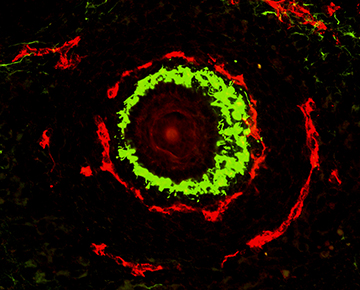
Curious anatomists performing human dissections 500 years ago observed that nerves and blood vessels often travel close together throughout the body. Although later studies revealed why—vessels provide nerves with vital nutrients and protection from toxins and pathogens, while nerves help regulate vessel size and heart rate—the question of how these complex networks develop in tandem has remained unanswered.
Recent scientific consensus held that nerves form first and direct blood vessels to follow their lead, at least in flat tissues such as skin. Now, Chenghua Gu, assistant professor of neurobiology at Harvard Medical School, and research fellow Won-Jong Oh have uncovered an alternate process in a more complex tissue: the base, or pad, of mouse whiskers.
Gu was the first to report that blood vessels and nerves form pairs of rings around individual whisker follicles. Through close study of these double rings, she and Oh found that the whisker pads, not the vessels or nerves themselves, send out molecular guidance cues that orchestrate local neurovascular formation.
The findings, published Oct. 16 in Neuron, might be relevant to diabetes, Alzheimer’s disease and other conditions that involve the degeneration of nerves and blood vessels.
Questioning ‘nerves first’
“I just wanted to challenge the model a little bit, because I felt like it wouldn’t be that simple,” said Gu. “I thought it was an important question to ask.”
Gu began by documenting the rings’ development step-by-step. She showed that vessels and nerves travel together to the whisker pads, form the inner nerve ring around each follicle and finally form the outer vessel ring.
She then studied genetically altered mice that lack a key facial nerve. The reigning theory suggested that absent nerves would leave developing blood vessels in chaos—but she found that the vessels developed normally.
To see if the converse were true, she looked at mice engineered to have poorly developed blood vessels around their whiskers. Again to her surprise, the nearby nerves formed normally.
“We can’t think of any evidence stronger than this to show that ‘one patterns the other’ is not always the case. There must be other mechanisms at work,” said Gu.
She concluded that the nerves and vessels must form independently from each other. But where were the directions coming from?
Balancing act
A series of in vitro and in vivo tests revealed a complex interplay of signals originating in the whisker pad. Working in concert, the signals guide the nerves and vessels to exactly where they need to be to best serve that tissue.
Gu and Oh confirmed that two well-studied proteins encourage nerves and vessels to grow toward the whisker pad.
They then found that a protein called Semaphorin 3E sends out a repulsive signal pushing them away from the follicle.
They also discovered that the nerve and the vessel express different levels of Plexin-D1, the protein that receives Semaphorin 3E’s signal. This leaves each balanced between the attractive and repulsive signals at a different distance from the follicle to form the double ring.
“As long as the nerves and vessels check on each other as they travel to the target tissue during development, that’s fine. When they reach the target, however, they encounter a completely different structure that is unique to that organ’s function. It makes sense that the organ serves as a central organizer to tell the nerves and vessels what to do,” said Gu.
“In the end, the result is the same—the nerves and vessels have this congruency. But not because one told the other. The central organ is the big boss.”
Next steps
Gu is turning next to the mouse brain, where, as in humans, nerves and vessels form dense, interrelated structures called neuronal units. The structures have been too complex to study until recently.
She hopes that what she finds will eventually translate to new therapies for nerve and vessel repair.
“Knowing the cues and the molecules involved, you have more tools to play with to help treat neurodegenerative diseases,” she said. “Any of these guidance molecules could be therapeutic targets.”
The study was supported by National Institutes of Health grant R01NS064583, a Sloan research fellowship, a March of Dimes Basil O’Connor award and an Armenise junior faculty award.
Relevant Journal Articles:
The Declaration of Independence of the Neurovascular Anatomy. Sophie Chauvet and Fanny Mann. Neuron, October 16, 2013.


